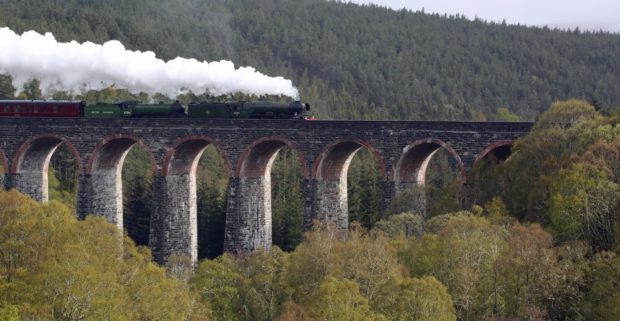
When first mooted, during the mid-1800s, the Perth to Inverness railway line was deemed too hilly for the steam trains of the day.
And when you realise the route crosses both the Drumochter and Slochd summits – 1,484 feet (452m) and 1,315 feet (401m) above sea level respectively – then it is easy to understand why.
However, such was the engineering skill of the Highland Railway company, that the 118-mile (190km) line opened in 1898.
With the arrival of the railway in 1863, Kingussie transformed itself from a small hamlet into a prosperous town and a fashionable holiday resort.
And, as for the rail line, the journey passes through a gorgeous and sometimes wild and barren portion along Scotland’s spine.
For the most part it hugs the line of the A9 and stops at such places as Birnam, Dunkeld, Pitlochry, Kingussie and Aviemore.
Travelling along the Perth to Inverness railway line provides the opportunity to climb hills and mountains like Birnam Hill, Ben Vrackie above Pitlochry, Drumochter’s A’Mharconaich and Creag Bheag near Kingussie.
Craigellachie National Nature Reserve is wonderful to wander around while the incredible Cairngorm Mountains are within reach from Aviemore.
In recent years Inverness has reinvented itself as a modern and cosmopolitan city and offers the chance to take the railway even further north, something we will be exploring in future Great Scottish Rail Journeys.
- During the 14th Century, Perth was acknowledged by the Staple Port of Bruges as one of Scotland’s four great towns, alongside Edinburgh, Aberdeen, and Dundee.
- Dunkeld became Scotland’s ecclesiastical centre during the 9th Century with the town’s focal point, Dunkeld Cathedral, being built between 1260 and 1501.
- Ruthven Barracks was one of four strategically placed barracks built by the government to tighten its grip on the Highlands after the 1715 Jacobite uprising.
- The spectacular woodland and birch pools of Craigellachie were declared a National Nature Reserve and a Site of Special Scientific Interest in 1961.
See more at scottishhorizons.photoshelter.com

Enjoy the convenience of having The Sunday Post delivered as a digital ePaper straight to your smartphone, tablet or computer.
Subscribe for only £5.49 a month and enjoy all the benefits of the printed paper as a digital replica.
Subscribe